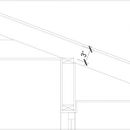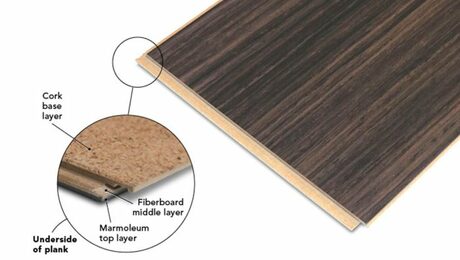Improve Poor Attic Insulation
My ranch home was built in Wisconsin in 1979 and we all know insulation wasn’t a high priority at that time. The roof has a relatively low slope and the way the eave was constructed produces a pinch point of about 3″ at the top plate. See attached image. In Wisconsin, where R-49 is required in the attic, 3″ of fiberglass insulation (about R-10) at that location means poor insulation, poor ventilation, and ice damming. What are my options for dealing with this condition? I’ve thought about doing something creative with board insulation, spray foam, or even converting to an unvented attic, but haven’t come up with a great solution yet. Any ideas would be appreciated.
GBA Detail Library
A collection of one thousand construction details organized by climate and house part










Replies
I also have this condition in my kitchen. The floor is cantilevered over the foundation wall eliminating the roof overhang. As you can see there is very little space available for attic insulation. I get ice dams at this location every winter.
Are the soffits in need of replacement? You can work from the outside with rigid foam over the top plate and ceiling drywall and also add venting. I have worked with companies here in MSP that will seal attic bypasses by moving the blown insulation. Then an additional insulation layer is added to code or beyond.
Unfortunately no, the soffits were replaced only a couple years ago.
There's no good way to work out at the eaves from the attic space -- there just isn't enough room. Your options would be to open up the roof, or open up the soffit or maybe the fascia.
If you're trying to maximize your insulation over that top plate, the best way to go is probably to slide in some 1" polyiso, leaving a 1" air gap above and a 1" gap to the top plate before. You want that 1" polyiso to go up into the attic space far enough to act as a dam for loose fill insulation, which probably means about 18-24 inches or so diagonally. Fill in that lower gap with enough spray foam to expand out over the top of the top plate a little on the attic side.
You'll probably need to open up the soffit to be able to do this work. I don't see any other options unless you want to put on a new roof.
One other thing that can help with ice dams is to make sure your soffit vents are out towards the far outside edge of the soffit as much as possible. This helps to minimize how much warmth from the walls will get up into the soffit and worsen the ice dams.
I'd double check air sealing of the upper level ceiling too. Any heat leaking up into the attic will only make ice dams worse.
Bill
Putting the vents on the facia board would get them as far out as possible.
I think I may add polyiso around the perimeter of the attic floor similar to what this guy did. https://youtu.be/pWKBf1QL1cg?t=120
He was replacing the roof sheathing so was able to do it easily from the exterior. Within the last few years I had the roof replaced and some fiberglass blown in the attic so I'll have to do it from inside the attic. My method would be to rake/shovel an area of insulation out of the way, add the polyiso, then move on to the next area until the entire attic is done.
Bryan,
You may want to read this article: "Insulating Tight Spaces at the Eaves."
Thanks Martin I found the article very helpful. The two primary recommendations just aren't feasible in my situation. I may do a combination of one or more of the "halfway measures" such as site built baffles out of polyiso and spray foam or polyiso under the baffles between the ceiling joists around the perimeter of the attic.
When the weather warms a little in early spring I may try the folowing with 1" polyiso and Rigid Foam Clips. For both pieces, which direction should the reflective foil face?
Does anyone have any ideas regarding the dropped soffit condition in comment #1? It's essentially inaccessible because of the pinch point under the roof sheathing. A possible solution that doesn't involve tearing down drywall, might be to add board insulation on the interior of the 2 soffit faces, then re-drywall using long drywall screws. However that's far from perfect because the bottom of the soffit lines up with other dropped headers around the room.
Soffits like that are commonly used to conceal ductwork. It’s entirely possible that there is something inside those so be careful if you try to demo anything.
Bill
There's nothing in the soffit. It's only there because the floor is cantilevered over the foundation wall below which eliminates the exterior overhang.
I'm currently making my way around the attic adding my homemade baffles to each rafter cavity, see photo. It's going pretty well but now my dilemma is what to do where my kitchen is cantileverd thus eliminating the overhang. The exterior overhang becomes an unvented interior soffit, and aside from a small 2" gap in the attic it's completely inaccessable. There is some fiberglass iniside the soffit but I don't know how much or how well. I'm trying to think of ways to improve this condition (in winter this area of the roof is always the first to melt) without completely opening up the soffit. The roof is only a couple years old so that's not an option right now. I think the only thing I can feasibly do is slide some board insulation down between the rafters much like all the other baffles I'm installing, then sealing the remainder of the pinch point w/ spray foam. My concern is creating a mositure problem. So the question is, since this is essentially an unvented "dense pack" condition, should I hold the board insulation off of the roof sheathing like the baffles so the soffit is connected to the rest of the primary attic and can breathe, or do I push the board insulation tight up against the bottom of the roof sheathing? I think I've read somewhere that dense pack insulation should be in contact with the roof. See details of option 1 and 2.
I would probably go with the long rigid foam baffle, but I wouldn't spray foam the upper level top plate. Just let your loose fill insulation fill in over the upper level top plate, which will allow for some slow diffusion so that moisture doesn't get trapped in the lower roof area. That's probably your best option. You don't need to worry about wind washing in the upper level area if the lower level area already has a baffle in place, so that upper level top plate only needs air sealing, not any blocking at the end the way you'd normally do if it was against a soffit.
Another option would be to use a hole saw to cut a few holes in the baffle just past the upper top plate and over the highest point in the lower roof area. That way the baffle also vents the lower roof area, sort of like an ersatz ridge vent. That's an option for you if you don't have an easy way to avoid sealing between the upper top plate and the baffle.
Bill